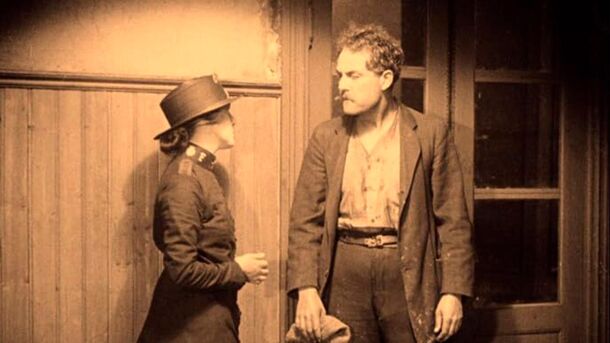The Shining's Most Iconic Scene Is an Homage to This 1920s Horror Classic

Come out, come out, wherever you are.
Summary:
- Stanley Kubrick’s most iconic Shining scene is the product of inspiration and originality.
- The Phantom Carriage, like The Shining, delves deep into the problem of addiction.
- Both The Phantom Carriage and The Shining share not only similar scenes but also similar messages.
In the shadowy world of horror movies, Stanley Kubrick's The Shining stands tall with its timeless scenes etched into the depths of our nightmares. The unforgettable "Here's Johnny!" moment, a blood-soaked revelation, now takes on a new meaning when you find out it owes its inspiration to a silent-era gem from the 1920s — Victor Sjöström's The Phantom Carriage.
Kubrick, a maestro of his craft, didn't just borrow; he resurrected a ghostly cinematic moment of the cult classic film and breathed new life into it for a modern audience.
What Is The Phantom Carriage About?

When we enter The Phantom Carriage, a silent black-and-white Swedish nightmare adapted from Selma Lagerlöf's 1912 novel, we encounter the haunting tale of David Holm, an eternal wanderer soaked in the ghosts of his own demons.
As the clock strikes midnight on New Year's Eve, a chilling revelation unfolds: the last soul to depart each New Year's Eve is doomed to drive Death's carriage, ferrying souls into the afterlife until another unfortunate soul takes the wheel the following year.
Here, Kubrick's fascination with this ethereal tale went far beyond a simple retelling. Even Steven King, the master behind The Shining novel, though skeptical of his book’s adaptation, witnessed Kubrick's unique approach — one that embraced influences and made his creations more like portals rather than replicas.
In Sjöström's hands, The Phantom Carriage becomes a moral tragedy, weaving threads of faith, alcoholism, and tuberculosis into a sinister web. David Holm's descent into darkness, fueled by the intoxication of spirits, mirrors Jack Torrance's unraveling in The Shining.
Kubrick masterfully channels Sjöström's atmospheric storytelling, using dialogue and facial expressions to construct tension reminiscent of the iconic axe-wielding scene in the Overlook Hotel.
The Phantom Carriage’s Influence On The Shining
As we witness David Holm's sinister attempt to infect his children with tuberculosis, the parallels to Jack's axe-swinging downfall become painfully clear. In a chilling echo of The Shining, David Holm, consumed by a toxic cocktail of rage and intoxication, confronts his children's bedroom door in a sinister cinematic symphony. The tension builds in a dialogue with his wife, Anna, in which David's expression mirrors Jack Torrance's breakdown at the Overlook Hotel.
While Wendy lands a blow on Jack, leaving him to freeze to death in the snow, David's moment of clarity comes as he witnesses Anna's fear-driven collapse. The tense dialogue and sinister facial expressions — all echo the Overlook's spiral into madness, and even Anna's desperate clutching of her children mirrors Wendy's struggle in The Shining.
Unleashing the enduring power of visionary storytelling, Kubrick's homage to Sjöström's classic is a testament to the resilience of filmmakers to transcend the limitations of technology in the pursuit of art.
In the shadowy corridors of cinematic history, Kubrick's tribute to The Phantom Carriage is a whispered acknowledgment from one spectral master to another, bridging the ethereal gap between eras and reminding us that for true horror, the confines of time and space don't exist.